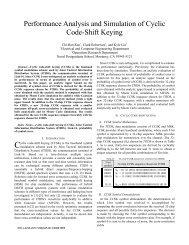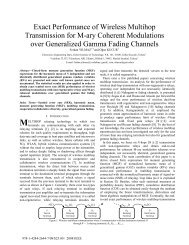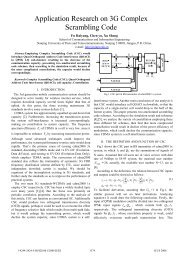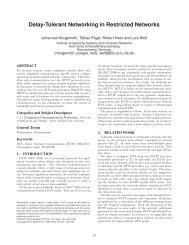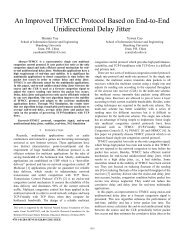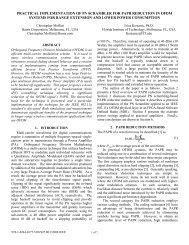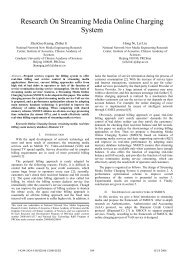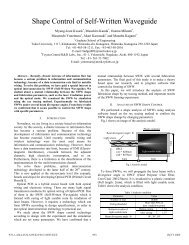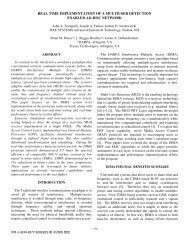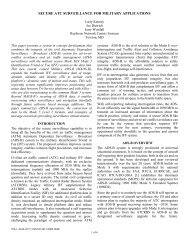DISN VIDEO SERVICES FOR FULL MOTION VIDEO
DISN VIDEO SERVICES FOR FULL MOTION VIDEO
DISN VIDEO SERVICES FOR FULL MOTION VIDEO
You also want an ePaper? Increase the reach of your titles
YUMPU automatically turns print PDFs into web optimized ePapers that Google loves.
<strong>DISN</strong> <strong>VIDEO</strong> <strong>SERVICES</strong> <strong>FOR</strong> <strong>FULL</strong> <strong>MOTION</strong> <strong>VIDEO</strong><br />
Bruce Bennett<br />
Defense Information Systems Agency<br />
Falls Church, VA<br />
ABSTRACT<br />
Full Motion Video from Unmanned and Manned Aerial<br />
Vehicles, ground and stationary sensors has been a<br />
mission critical tool and a force multiplier for OIF and<br />
OEF, providing real-time video for Counter-<br />
Reconnaissance, Intelligence, Surveillance, and Target<br />
Acquisition. The number of sensors in theatre today has<br />
resulted in the development of disparate FMV<br />
distribution architectures to support the dissemination<br />
requirements of specific users and operations. Because<br />
underlying systems and platforms were developed<br />
independently, and for varying missions; backhaul,<br />
collection, storage, and dissemination were neither<br />
synchronized nor standardized. This approach created a<br />
hodge-podge of solutions, each designed to their own<br />
environment, but poorly suited for integration into other<br />
intelligence and command and control architectures.<br />
In response to this problem, DISA is working to establish<br />
an Enterprise FMV Program of Record that will develop<br />
a unified strategy and architecture to resolve the<br />
common sensor reachback and dissemination problem<br />
for full motion video. The <strong>DISN</strong> Video Service for FMV<br />
will leverage existing Programs of Record, ongoing<br />
demonstrations and prototypes, and defined DoD and<br />
commercial standards to provide a shared service that<br />
integrates with the 2016 Vision for the GIG. The<br />
routing, ingest, processing, archival and dissemination<br />
of the video will be supported at the Defense Enterprise<br />
Computing Centers (DECC) and will leverage existing<br />
<strong>DISN</strong> services and new services like the Unified Video<br />
Dissemination System (UVDS). The UVDS prototype, a<br />
funded Defense Acquisition Challenge Proposal<br />
supported by DISA and the Air Force, provides the basis<br />
for a DoD enterprise-wide, unified FMV architecture<br />
that will provide a common reachback transport,<br />
archival and dissemination for all full motion video.<br />
INTRODUCTION<br />
The improvised explosive device (IED) has defined a<br />
new battleground for a low technology approach to<br />
978-1-4244-2677-5/08/$25.00 ©2008 IEEE<br />
1 of 5<br />
and<br />
Dave Beliveau, Mark Snellings, Mike Harding<br />
TeraLogics LLC<br />
Ashburn,VA<br />
Dillon Bussert<br />
Booz Allen Hamilton<br />
Herndon, VA<br />
combat the coalition’s clear and unchallenged<br />
technological and force projection advantages in<br />
Operation Iraqi Freedom (OIF) and Operation Enduring<br />
Freedom (OEF). Early in peacekeeping efforts, the IED<br />
caused significantly more coalition causalities than any<br />
conventional weapon. 1 From July 2003 to June 2008<br />
there have been 1787 fatalities caused by IEDs. 1702 of<br />
these deaths have been to US forces and personnel. 2<br />
In response to continuing IED attacks, one of the most<br />
effective responses of the coalition forces is the<br />
increased reliance on Unmanned Aerial Systems (UAS)<br />
and their primary Intelligence, Surveillance and<br />
Reconnaissance (ISR) product, full motion video<br />
(FMV). Initially, FMV was used to simply provide<br />
improved situational awareness and an enhanced view of<br />
a local area. Local commanders could view suspicious<br />
activity in near real-time and act upon them<br />
appropriately. Other than a few national UAS assets that<br />
were flown from CONUS (Continental United States),<br />
the FMV was locally controlled and locally consumed.<br />
The need for backhaul, storage and dissemination of<br />
bandwidth consuming UAS video seemed overly<br />
expensive relative to the perceived benefits.<br />
The role of FMV as a mission critical tool has evolved<br />
as insurgent forces have increasingly used stealthy<br />
means and refined CONOPS (Concept of Operations) to<br />
disrupt peacekeeping operations. With improved<br />
backhaul and dissemination provided by programs such<br />
as DVB-RCS (Digital Video Broadcast – Return<br />
Channel via Satellite), Task Force ODIN (Observe,<br />
Detect, Identify, Neutralize) and the Global Broadcast<br />
Service (GBS), persistent video surveillance,<br />
collaborative analysis, and networked storage of<br />
historical FMV has led to improved force protection and<br />
infiltration of insurgent groups. Task Force ODIN, an<br />
early effort to provide and share manned and unmanned<br />
aircraft FMV and other intelligence, is credited with 148<br />
1 Andrew E. Kramer. NY Times 5 June 2008.<br />
2 Iraq Coalition Casualty Count. Retrieved June 6, 2008, from<br />
http://icasualties.org/oif/IED.aspx.
sensor-to-shooter handoffs resulting in over 500 IED<br />
emplacers killed, injured or captured through August<br />
2007. 3<br />
This successful counter-insurgency, supported by FMV<br />
dissemination and analysis tools, is possible because<br />
IED attacks do not take place in a vacuum. Insurgents<br />
must acquire materiels, build the bomb, reconnoiter the<br />
target, and finally plant the IED. Real-time video may<br />
expose those planting the weapon, but recorded and<br />
exploited video can reveal concepts of operations,<br />
surveillance techniques, materials used, or even other<br />
individuals involved in the planning process. As a result<br />
this information can lead to capture and elimination of<br />
an insurgent cell rather than just the neutralization of a<br />
single individual device.<br />
As Task Force ODIN has demonstrated on a tactical<br />
scale, the key to this counter IED application is a<br />
common robust framework for encoding, backhaul,<br />
routing, analysis, storage and dissemination for FMV<br />
and related video products. These products must be<br />
readily available over common user networks, adaptable<br />
for a variety of robust and constrained communications<br />
environments, easily integrated into any standardscompliant<br />
exploitation tool and shareable with a variety<br />
of end-users including shooters and other manned<br />
aircraft.<br />
The next evolution of full motion video as a force<br />
protection tool is to extend this tactical asset from<br />
theatre to the DoD Enterprise to support common<br />
storage, access and dissemination of full motion video<br />
for all sensors including unmanned and manned aerial<br />
platforms, ground and stationary sensors. In order to<br />
leverage FMV for its expanded operational role, an<br />
enterprise-wide DoD solution is necessary for a unified<br />
approach to this ISR asset. Because of the cost,<br />
complexity and inherent synergies associated with a<br />
centralized video solution, full motion video is the ideal<br />
enterprise application.<br />
ENTERPRISE <strong>FULL</strong> <strong>MOTION</strong> <strong>VIDEO</strong><br />
In 2000, the US Air Force (USAF) requested the<br />
Defense Information System Agency’s (DISA)<br />
assistance with the provisioning of wideband circuits<br />
across the <strong>DISN</strong> (Defense Information Systems<br />
Network) ATM Service (DATMS) for reachback and<br />
3 UAVs are Decisive Factor in Decline in Iraq IED Attacks.<br />
Retrieved June 6, 2008, from http://defencedata.com/current/page38536.htm.<br />
2 of 5<br />
dissemination of Predator FMV feeds. A joint effort<br />
established connections between Ramstein, Germany<br />
(common SATCOM Downlink for Predator traffic) and<br />
Langley AFB over DATMS (site of the closest Predator<br />
Common Ground Station) with additional capabilities to<br />
enable USAF personnel to route streams to any<br />
appropriate DATMS user. As additional Predators were<br />
pushed forward, the number of missions disseminated<br />
through Langley increased and exceeded site<br />
capabilities, resulting in Air Combat Command (ACC)<br />
establishing the Predator Operations Center – Nellis<br />
(POC-N) at Nellis/Creech AFB and transferring the<br />
command and control of Predator operations and the<br />
Video Dissemination Hubs (VDH) in FY07. POC-N<br />
distributes the Predator broadcast video to over 38 sites<br />
in CONUS and OCONUS and requires more than<br />
550Mbps of bandwidth on the DATMS network.<br />
In April 2007, the ACC A6 requested assistance from<br />
the DISA Vice Director to develop a strategy and<br />
architecture to resolve the common sensor reachback and<br />
dissemination problem for full motion video. DISA<br />
GE23 was tasked with developing a strategy and<br />
evolution plan for an Enterprise Full Motion Video<br />
service. USCENTCOM (US Central Command) has<br />
also concurred with DISA taking a leadership role which<br />
would include working across Services and DoD<br />
stakeholder communities to reconcile and address video<br />
dissemination requirements.<br />
CHALLENGES TO ENTERPRISE <strong>VIDEO</strong><br />
Although full motion video plays a significant role in<br />
missions in OIF and OEF today, reachback, storage and<br />
dissemination of this video has not been consistently<br />
applied across the DoD due to the lack of a standard<br />
architecture, program of record or executive agent, clear<br />
requirements, CONOPS and TTPs (Tactics, Techniques<br />
and Procedures) and network bandwidth.<br />
New sensor platforms continue to be deployed without<br />
any unified operational sponsorship and absent any<br />
coordinated effort to resource, develop, and implement a<br />
common reachback or dissemination method. Each<br />
unique sensor program typically designs and implements<br />
their own architecture, leading to redundant capabilities<br />
implemented by multiple organizations. A common<br />
method for transport is to use the existing Predator<br />
reachback and dissemination paths which has<br />
overburdened the POC-N infrastructure and resulted in<br />
ACC being unable to support the Warrior Alpha, Scan<br />
Eagle, BAM and I-GNAT missions. DVB-RCS has<br />
provided a reachback capability for many tactical<br />
sensors in CENTCOM, but the <strong>DISN</strong> lacks a unified and
global, dissemination architecture that supports Predator<br />
and tactical video and other Combatant Commands.<br />
Without a common FMV architecture, organizations will<br />
continue to develop stove-piped solutions for each new<br />
sensor platform and mission that is deployed.<br />
A Program of Record or Executive Agent for FMV<br />
dissemination within the joint community is needed to<br />
provide a unified FMV strategy and architecture. The<br />
National Geospatial Agency (NGA) has the charter to<br />
determine video standards through the Motion Imagery<br />
Standards Board (MISB), but that represents the only<br />
point of commonality between FMV outside of the<br />
DISA transmission networks. No single organization<br />
has the responsibility to develop a backhaul, storage and<br />
dissemination strategy across the DoD that can be<br />
implemented by all platforms and systems.<br />
The absence of a documented and validated Joint<br />
operational requirement for a full motion video<br />
reachback and dissemination strategy, architecture and<br />
capability, has led existing strategies to instead focus on<br />
the performance of individual platforms and their<br />
embedded sensor packages. Requirements for<br />
dissemination and a program advocate are needed to<br />
direct the sensor platforms, video consumers and<br />
transport towards a common vision for full motion<br />
video. Video producers and consumers would greatly<br />
benefit from CONOPs and TTPs defining uses for<br />
enterprise and tactical video and requirements for video<br />
quality, storage length and formats. Many current<br />
systems store video for an arbitrary 30 days, or until disk<br />
space is exhausted, but it is not clear what bitrate is<br />
needed and in what situations video should be stored<br />
longer, or not stored at all.<br />
From a communications and computing perspective, full<br />
motion video is extremely challenging to deal with.<br />
Even with state-of-the-art encoding and compression<br />
schemes such as MPEG-4/H.264, broadcast quality<br />
video requires at least a megabit per second of<br />
bandwidth to transmit a single FMV stream. In addition,<br />
to eliminate pixilation and other artifacts, the link must<br />
have minimal jitter. Operational needs often impose<br />
even more stringent requirements on the transmission<br />
systems such as minimal latency, higher resolution and<br />
increased quality of service for sensor to shooter<br />
missions, while network constrained end users require<br />
video at lower bitrates for situational awareness.<br />
Although these programmatic and technical challenges<br />
already exist, operational need for full motion video to<br />
support the Warfighter has continued to grow<br />
exponentially. Near-term efforts such as the ISR Task<br />
3 of 5<br />
Force, Liberty Ship and Predator QRC (Quick Reaction<br />
Capability) and long term plans like ERMP (Extended-<br />
Range Multi-Purpose UAV) and UGCS (Universal<br />
Ground Control Station) demonstrate how UAS and the<br />
full motion video that they generate will become an even<br />
more critical asset as the Global War on Terror<br />
continues. The already strained reachback and<br />
dissemination capabilities in place today and stove-piped<br />
systems will require a significant overhaul to fully utilize<br />
assets being deployed into theatre.<br />
ENTERPRISE ARCHITECTURE<br />
DISA is working to establish an Enterprise FMV<br />
Program of Record that will develop a unified strategy<br />
and architecture for full motion video. DISA GE23 has<br />
taken a lead role in establishing a vision for FMV and is<br />
currently working to align existing systems and<br />
technology demonstrations to build a shared Enterprise<br />
<strong>DISN</strong> Video Service for FMV. The architecture that is<br />
being developed for enterprise FMV consists of three<br />
key components: reachback, processing and storage, and<br />
dissemination of video.<br />
Currently UAS video in CENTCOM is backhauled using<br />
the Predator Primary Satellite Link (PPSL) with feeds<br />
coming directly from the airframe over satellite to Nellis<br />
AFB or DVB-RCS which encodes video at the tactical<br />
ground station and backhauls the multicast stream to the<br />
satellite hub at the Landstuhl, Germany Teleport. DVB-<br />
RCS has served as the main transport for TACVID<br />
(Tactical Video) in CENTCOM since its deployment in<br />
2006, supporting Task Force ODIN and Warrior Alpha,<br />
Shadow, Hunter and ARMS systems. Without a<br />
reachback capability to backhaul, and eventually<br />
disseminate video, these systems would not be able to<br />
broadcast video to BLOS (Beyond Line of Site) sites,<br />
and would only deliver FMV to analyst systems locally<br />
connected to the ground control station or line of sight<br />
handheld receivers.<br />
A common backhaul transport is needed for the backhaul<br />
of FMV from theatre as new tactical sensors are<br />
deployed. DVB-RCS will continue to support TACVID<br />
backhaul as a current solution, but the future FMV<br />
architecture will rely on the two-way Global Broadcast<br />
Service (GBS) and Joint IP Modem (JIPM) to move<br />
video worldwide. As part of a technology upgrade, GBS<br />
will be deploying the JIPM to current and future oneway<br />
GBS Receive Suites to provide TRANSEC<br />
(Transmission Security) and a two-way IP SATCOM<br />
capability. The Joint IP Modem, based on the DVB-<br />
RCS ETSI (European Telecommunication Standards<br />
Institute) standard, is a commercial-off-the-shelf modem,
enhanced to meet DoD requirements for Information<br />
Assurance (IA).<br />
GBS two-way suites will be deployed worldwide to<br />
backhaul data over the Wideband Global SATCOM<br />
(WGS) system. The JIPM modem will connect to a<br />
Joint IP Modem hub installed at the DoD Teleports,<br />
providing the ability to disseminate back into theatre or<br />
connect to an Enterprise Service on the Global<br />
Information Grid (GIG). Two-way GBS will augment<br />
the WIN-T network by satisfying requirements for<br />
TACVID, allowing the WIN-T network to be used for its<br />
primary mission of delivering command and control<br />
data.<br />
Collection, processing and archival of FMV on the<br />
enterprise will be hosted by the Defense Enterprise<br />
Computing Centers (DECC) and will leverage existing<br />
<strong>DISN</strong> resources. The DECCs are data centers managed<br />
by DISA that provide secure, accredited hosting for<br />
services and applications in CONUS and OCONUS<br />
(Outside CONUS) and are designed with the necessary<br />
infrastructure to support the high throughput, processing<br />
and storage needed for FMV. The DoD Teleports and<br />
DECCs are connected to the <strong>DISN</strong> optical core and can<br />
transport large amounts of data between sites<br />
terrestrially. An Enterprise FMV service deployed at the<br />
DECCs can consume video being backhauled to the<br />
JIPM hub across the <strong>DISN</strong> with minimal latency and<br />
jitter, and archive the FMV using high performance<br />
storage networks to support the volume of content being<br />
backhauled over WGS. The DECCs will provide a<br />
centralized collecting point for all FMV in the Enterprise<br />
and provide a common bridge between video producers<br />
and consumers, eliminating redundant and stove-piped<br />
networks.<br />
Services for processing video will be installed on servers<br />
managed by the DECC. On-site system administrators<br />
will configure networks for video streams, monitor<br />
system status and apply security measures to ensure IA<br />
compliance. Enterprise FMV services will ensure<br />
ingested video is available in Motion Imagery Standards<br />
Profile (MISP) compliant format, MPEG-2 or MPEG-4<br />
H.264 video with Key Length Variable (KLV) and<br />
Cursor on Target (CoT) metadata. Standards based<br />
encoding, metadata, and transmission protocols will<br />
provide a common baseline that can be leveraged by<br />
existing enterprise and tactical exploitation tools.<br />
Existing systems will be integrated through web services<br />
interfaces to minimize end user impacts and maximize<br />
interoperability.<br />
4 of 5<br />
The dissemination component of the Enterprise FMV<br />
service will deliver video through the <strong>DISN</strong> for<br />
terrestrial connections and GBS for tactical users. The<br />
FMV Service will support transcoding and transrating of<br />
video from the full quality bitrate, which currently<br />
ranges from 1Mbps to 6Mbps, to a lower bitrate to meet<br />
mission requirements and end user network throughput.<br />
Situational awareness can be delivered through video<br />
dynamically reduced to 56Kbps, while FMV for analysis<br />
will be delivered at the highest possible bitrate.<br />
The Enterprise FMV dissemination capability can be<br />
used to transfer Video Distribution Hub responsibilities<br />
from ACC to DISA and redirect Predator consumers to<br />
the <strong>DISN</strong> Video Services provided at the DECC on the<br />
<strong>DISN</strong> core, eliminating the need for point-to-point ATM<br />
connections to consumer sites. Predator on-board<br />
encoded video and GBS two-way tactical video will be<br />
sent to <strong>DISN</strong> Video Services where it will be made<br />
available to consumers on the <strong>DISN</strong> and over tactical<br />
communications. The DECC VDH on the <strong>DISN</strong> core<br />
can provide high bandwidth, network diversity and selfhealing<br />
transports to deliver full motion video streams.<br />
UVDS ROLE AND IMPACT<br />
The Unified Video Dissemination System (UVDS)<br />
Defense Acquisition Challenge Program (DACP) was<br />
created to alleviate much of the FMV dissemination<br />
problem. UVDS will provide a prototype and an early<br />
implementation capability that will map the path to the<br />
Enterprise <strong>DISN</strong> Service for FMV. UVDS is a major<br />
component of DISA’s FMV vision to merge a diverse<br />
group of stakeholders and system architectures into a<br />
robust service that consolidates the FMV ingest, routing<br />
and dissemination services into an integrated standardsbased<br />
delivery system.<br />
Figure 1. UVDS is designed to ingest, route and<br />
disseminate video to enterprise and tactical consumers<br />
The complete UVDS solution consists of five core<br />
architectural components as shown in Figure 1. The<br />
goal of these components is to offload the difficult and
computationally intensive video dissemination processes<br />
onto a single unified system. When fully<br />
operationalized the UVDS system will have direct<br />
access to the all the videos from Predator and the DVB-<br />
RCS system. It will also have access to any network<br />
based feeds that are coming from theater and will be able<br />
to ingest products from exploitation systems or raw<br />
video from storage devices. The resulting system will<br />
improve FMV dissemination by eliminating the<br />
expensive and inefficient piecemeal architecture that<br />
often degrades video quality, adds latency to the FMV<br />
streams, and wastes valuable and expensive bandwidth.<br />
A real world example of UVDS’s potential impact is the<br />
FMV support provided during Hurricane Katrina. In<br />
response the natural disaster, ScatheView (FMV from<br />
manned aircraft) was deployed to provide search and<br />
rescue support as well as damage assessment of New<br />
Orleans and surrounding areas. The system was<br />
deployed with a Rover downlink terminal to receive the<br />
aircraft video and convert it to an analog format. In<br />
order to disseminate the video, the Rover analog feed<br />
was provided to the deployed GBS Theater Satellite<br />
Broadcast Manager (TSBM) which converted it to an<br />
MPEG-2 format and sent it to the GBS uplink for further<br />
dissemination to numerous CONUS locations including<br />
NORTHCOM. At NORTHCOM, the video was brought<br />
back to analog and then re-encoded using Windows<br />
Media and rebroadcast using a SIPRNET network<br />
connection. From beginning to end, the video traversed<br />
wireless and satellite links, was subjected to three analog<br />
to digital conversions and the final product consumed by<br />
the end user was severely degraded from the original.<br />
An Enterprise <strong>DISN</strong> FMV service based on the UVDS<br />
system could have eliminated all but one of the satellite<br />
hops and all but one of the analog to digital conversions.<br />
Furthermore, the need to deploy non-standard, expensive<br />
dissemination systems in addition to their existing<br />
common user systems such as GBS would be eliminated.<br />
In this scenario, UVDS and the <strong>DISN</strong> FMV service<br />
could have improved performance, significantly lowered<br />
costs, reduced implementation time and simplified the<br />
backhaul and dissemination solution.<br />
Some of the key benefits of the UVDS system are shown<br />
in Figure 2.<br />
5 of 5<br />
Figure 2. Key benefits of UVDS include universal<br />
access and automated routing across the <strong>DISN</strong><br />
CONCLUSIONS<br />
A common FMV architecture to enable distribution<br />
throughout the <strong>DISN</strong> supporting processing, exploitation<br />
and dissemination will enable the expansion of FMV<br />
applications to wider variety of end users. This<br />
capability will provide state of the art services for realtime<br />
video streaming, archival and storage and metadata<br />
tagging to enhance the planning and execution of joint<br />
military and coalition operations.<br />
The role of full motion video in OIF and OEF continues<br />
to evolve to counter insurgency and provide force<br />
protection for IED threats. Full motion video<br />
dissemination has moved from a localized asset to a<br />
theatre-wide resource that can be distributed and<br />
analyzed to support multiple Warfighter missions. The<br />
future of FMV is a unified strategy for platforms and<br />
sensors and a common Enterprise architecture for<br />
backhaul, storage and dissemination of video. DISA has<br />
championed the concept of an Enterprise <strong>DISN</strong> Video<br />
Service for FMV at the Defense Enterprise Computing<br />
Centers to backhaul, archive and distribute video over<br />
the <strong>DISN</strong> Core. This Enterprise Service will integrate<br />
existing and emerging systems like DVB-RCS, and<br />
eventually two-way GBS and UVDS to develop a joint<br />
vision for the future of full motion video.<br />
The authors wish to thank the following individuals for<br />
their invaluable contributions to this publication: Rose<br />
Thomas, Michael Skowrunski and Rebecca Pham.



